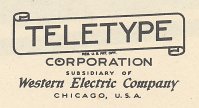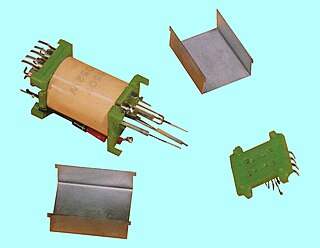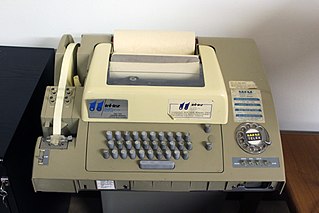
A teleprinter is an electromechanical device that can be used to send and receive typed messages through various communications channels, in both point-to-point and point-to-multipoint configurations.
Direct distance dialing (DDD) is a telecommunications service feature in North America by which a caller may, without operator assistance, call any other user outside the local calling area. Direct dialing by subscribers typically requires extra digits to be dialed as prefixes to the directory telephone number of the destination. International Direct Distance Dialing (IDDD) extends the system beyond the geographic boundaries of the North American Numbering Plan (NANP).

The North American Numbering Plan (NANP) is a telephone numbering plan for twenty-five regions in twenty countries, primarily in North America and the Caribbean. This group is historically known as World Zone 1 and has the telephone country code 1. Some North American countries, most notably Mexico, do not participate with the NANP.
The 12-hour clock is a time convention in which the 24 hours of the day are divided into two periods: a.m. and p.m.. Each period consists of 12 hours numbered: 12, 1, 2, 3, 4, 5, 6, 7, 8, 9, 10, and 11. The 12-hour clock has been developed since the second millennium BC and reached its modern form in the 16th century.

The Trimline telephone is a series of telephones that was produced by Western Electric, the manufacturing unit of the Bell System. These telephones were first introduced in 1965 and are formally referred to as the No. 220 Hand Telephone Sets. The Trimline was designed by Henry Dreyfuss Associates under the project direction of Donald Genaro; the firm had produced the previous post-war desktop telephone types for the American Telephone & Telegraph Company.

A clock face is the part of an analog clock that displays time through the use of a flat dial with reference marks, and revolving pointers turning on concentric shafts at the center, called hands. In its most basic, globally recognized form, the periphery of the dial is numbered 1 through 12 indicating the hours in a 12-hour cycle, and a short hour hand makes two revolutions in a day. A long minute hand makes one revolution every hour. The face may also include a second hand, which makes one revolution per minute. The term is less commonly used for the time display on digital clocks and watches.

A speaking clock or talking clock is a live or recorded human voice service, usually accessed by telephone, that gives the correct time. The first telephone speaking clock service was introduced in France, in association with the Paris Observatory, on 14 February 1933.

A stopwatch is a timepiece designed to measure the amount of time that elapses between its activation and deactivation.

A chronograph is a specific type of watch that is used as a stopwatch combined with a display watch. A basic chronograph has hour and minute hands on the main dial to tell the time, a small seconds hand to tell that the watch is running, and a seconds hand on the main dial usually equipped with a sweeping movement for precision accompanied by a minutes sub dial for the stopwatch. Another sub dial to measure the hours of the stopwatch may also be included on a chronograph. The stopwatch can be started, stopped, and reset to zero at any time by the user by operating pushers usually placed adjacent to the crown. More complex chronographs often use additional complications and can have multiple sub-dials to measure more aspects of the stopwatch such as fractions of a second as well as other helpful things such as the moon phase and the local 24-hour time. In addition, many modern chronographs include tachymeters on the bezels for rapid calculations of speed or distance. Louis Moinet invented the chronograph in 1816 for use in tracking astronomical objects. Chronographs soon found a widespread use in artillery fire in the mid to late 1800s. Over time, the chronograph found its use to be in several different fields, such as aircraft piloting, auto racing, diving and submarine maneuvering.
In telecommunications, a long-distance call (U.S.) or trunk call is a telephone call made to a location outside a defined local calling area. Long-distance calls are typically charged a higher billing rate than local calls. The term is not necessarily synonymous with placing calls to another telephone area code.

The Western Electric model 500 telephone series was the standard domestic desk telephone set issued by the Bell System in North America from 1950 through the 1984 Bell System divestiture. The successor to the model 302 telephone, the model 500's modular construction compared to previous types simplified manufacture and repair and facilitated a large number of variants with added features. Touch-tone service was introduced to residential customers in 1963 with the model 1500 telephone, which had a push-button pad for the ten digits. The model 2500 telephone, introduced in 1968, added the * (asterisk) and # (pound) keys.

The model 302 telephone is a desk set telephone that was manufactured in the United States by Western Electric from 1937 until 1955, and by Northern Electric in Canada until the late 1950s, until well after the introduction of the 500-type telephone in 1949. The sets were routinely refurbished into the 1960s. It was one of the most widely used American combined telephone sets to include the ringer and network circuitry in the same telephone housing.
See 'n Say is an educational toy created by Mattel in 1964 after the success of Chatty Cathy. It was the first Mattel talking toy allowing children to choose the exact phrase as heard. Although the first release focuses on farm animal sounds, it had spawned through many themes from the alphabet, counting, nursery rhymes, to licensed products.

Ericsson Dialog is a Swedish telephone model by Ericsson, released 1964. Millions of the model were sold and it retained its place in homes well into the 1990s. The Ericsson company presented King Carl XVI Gustaf of Sweden with a unique handmade Dialog telephone on his 40th birthday.

The Teletype Corporation, a part of American Telephone and Telegraph Company's Western Electric manufacturing arm since 1930, came into being in 1928 when the Morkrum-Kleinschmidt Company changed its name to the name of its trademark equipment. Teletype was responsible for the research, development and manufacture of data and record communications equipment, but it is primarily remembered for the manufacture of electromechanical teleprinters.

TXE, was a family of telephone exchanges developed by the British General Post Office (GPO), designed to replace the ageing Strowger switches.
The General Post Office (GPO) of the United Kingdom carried the sole responsibility for providing telecommunication services across the country with the exception of Hull. The GPO issued a range of telephone instruments to telephone service subscribers that were matched in function and performance to its telephone exchanges.

Telex is a telecommunication system that allows text-based messages to be sent and received by teleprinter over telephone lines. The term "telex" may refer to the service, the network, the devices, or a message sent using these. Telex emerged in the 1930s and became a major method of sending text messages electronically between businesses in the post–World War II period. Its usage declined as the fax machine grew in popularity in the 1980s.

The Western Electric hand telephone sets are a series of telephones that were produced from 1927 by the Western Electric Company for the American Telephone and Telegraph Company (AT&T) and the Bell System. The series features the mouthpiece (transmitter) and the earpiece (receiver) combined into a hand-held unit, originally named a hand telephone, or handset. The handset would be held against the ear and in front of the mouth simultaneously, in contrast to earlier telephones in the Bell System where only the receiver was held against the ear, while the user spoke into a fixed transmitter mounted on a telephone stand or wall telephone.

A photo-lab timer,photo interval timer, or darkroom timer is a timer used in photography for timing the process of projecting negatives to photosensitive paper with an enlarger, making photographic prints of them at any scale. It is a device which is attached to the photo lab enlarger to ensure that the duration of photo exposures on sensitive paper can be accurately timed. When the selected time has elapsed, the enlarger is switched off or an alarm is sounded, for the photographer to turn it off.















